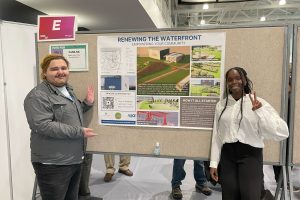
In April, a team of undergraduate engineering students was awarded second place in the first round of the American Society of Civil Engineers (ASCE) 2024 Sustainable Solutions Competition (SSC), which was held at the University of Maryland College Park and encourages students to develop a stronger understanding of sustainability and apply sustainable solutions to engineering challenges.
This year’s competition required teams to respond to a hypothetical Request for Proposal (RFP) to revitalize the waterfront area of the fictional City of ASCE, which is described as an early 20th-century manufacturing hub on the Big Brown River that has since fallen into decline and abandonment.
“In the hypothetical RFP, we were asked to redevelop three parcels of a waterfront area using the Institute for Sustainable Infrastructure’s Envision framework,” said team member and civil and engineering student Claudio Kochell. “Our team put together a design that revitalizes land-use and economic activity and incorporates nature-based solutions (NBS) and engineering with nature (EWN) approaches.”
The team comprised students majoring in civil and systems engineering, environmental engineering, chemical and biomolecular engineering, and computer science, demonstrating that sustainability is a universal consideration that applies to multiple fields of study.
“Our proposal featured a comprehensive design, including demolishing four existing grain silos, renewing the three parcels of land with commercial and residential properties, and managing flooding and water quality issues,” said team member and computer science major Adeola Ojuade.
The team’s proposal included a flood and stormwater management plan, adequate parking solutions, safe multi-modal transportation access using an abandoned railway corridor, an evacuation and severe weather conditions management plan, and surrounding green space. The design also honored the fictional city’s historical and cultural significance with a commemorative sculpture.
“We wanted to create a design that wasn’t just functional but also sustainable and respectful of the area’s history,” said Kochell.
First-place winners from the regional competitions will advance to the ASCE society-wide competition finals, scheduled for June 20-22 at Brigham Young University where teams from across the country will compete for trophies and cash prizes.